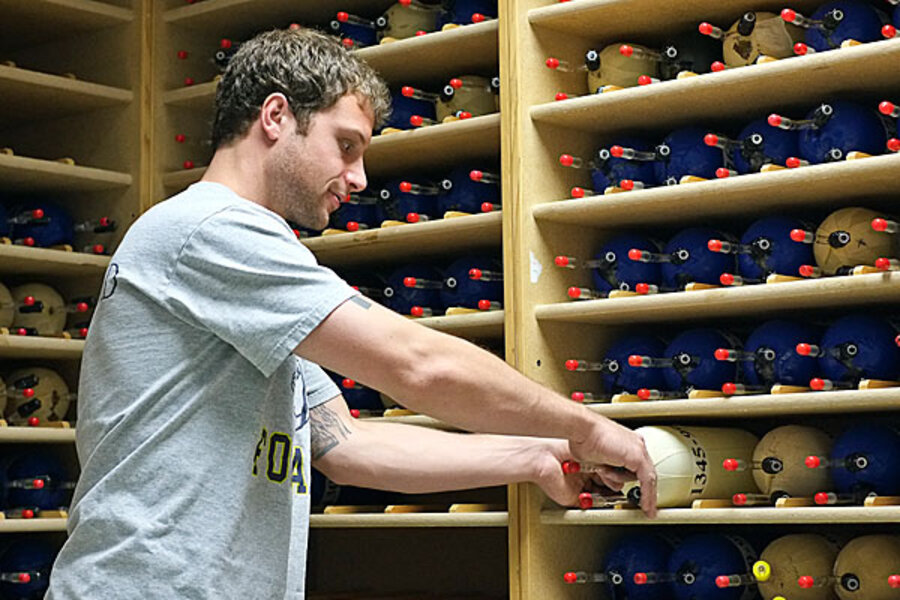Climate change: Arctic passes 400 parts per million milestone
Loading...
| Washington
The world's air has reached what scientists call a troubling new milestone for carbon dioxide, the main global warming pollutant.
Monitoring stations across the Arctic this spring are measuring more than 400 parts per million of the heat-trapping gas in the atmosphere. The number isn't quite a surprise, because it's been rising at an accelerating pace. Years ago, it passed the 350 ppm mark that many scientists say is the highest safe level for carbon dioxide. It now stands globally at 395.
So far, only the Arctic has reached that 400 level, but the rest of the world will follow soon.
RECOMMENDED: How much do you know about climate change? Take the quiz
"The fact that it's 400 is significant," said Jim Butler, global monitoring director at the National Oceanic and Atmospheric Administration's Earth System Research Lab in Boulder, Colo. "It's just a reminder to everybody that we haven't fixed this and we're still in trouble."
Carbon dioxide is the chief greenhouse gas and stays in the atmosphere for 100 years. Some carbon dioxide is natural, mainly from decomposing dead plants and animals. Before the Industrial Age, levels were around 275 parts per million.
For more than 60 years, readings have been in the 300s, except in urban areas, where levels are skewed. The burning of fossil fuels, such as coal for electricity and oil for gasoline, has caused the overwhelming bulk of the man-made increase in carbon in the air, scientists say.
It's been at least 800,000 years — probably more — since Earth saw carbon dioxide levels in the 400s, Butler and other climate scientists said.
Until now.
Readings are coming in at 400 and higher all over the Arctic. They've been recorded in Alaska, Greenland, Norway, Iceland and even Mongolia. But levels change with the seasons and will drop a bit in the summer, when plants suck up carbon dioxide, NOAA scientists said.
So the yearly average for those northern stations likely will be lower and so will the global number.
Globally, the average carbon dioxide level is about 395 parts per million but will pass the 400 mark within a few years, scientists said.
The Arctic is the leading indicator in global warming, both in carbon dioxide in the air and effects, said Pieter Tans, a senior NOAA scientist.
"This is the first time the entire Arctic is that high," he said.
Tans called reaching the 400 number "depressing," and Butler said it was "a troubling milestone."
"It's an important threshold," said Carnegie Institution ecologist Chris Field, a scientist who helps lead the Nobel Prize-winning Intergovernmental Panel on Climate Change. "It is an indication that we're in a different world."
Ronald Prinn, an atmospheric sciences professor at the Massachusetts Institute of Technology, said 400 is more a psychological milestone than a scientific one. We think in hundreds, and "we're poking our heads above 400," he said.
Tans said the readings show how much the Earth's atmosphere and its climate are being affected by humans. Global carbon dioxide emissions from fossil fuels hit a record high of 34.8 billion tons in 2011, up 3.2 percent, the International Energy Agency announced last week.
The agency said it's becoming unlikely that the world can achieve the European goal of limiting global warming to just 2 degrees based on increasing pollution and greenhouse gas levels.
"The news today, that some stations have measured concentrations above 400 ppm in the atmosphere, is further evidence that the world's political leaders — with a few honorable exceptions — are failing catastrophically to address the climate crisis," former Vice President Al Gore, the highest-profile campaigner against global warming, said in an email. "History will not understand or forgive them."
But political dynamics in the United States mean there's no possibility of significant restrictions on man-made greenhouse gases no matter what the levels are in the air, said Jerry Taylor, a senior fellow of the libertarian Cato Institute.
"These milestones are always worth noting," said economist Myron Ebell at the conservative Competitive Enterprise Institute. "As carbon dioxide levels have continued to increase, global temperatures flattened out, contrary to the models" used by climate scientists and the United Nations.
He contends temperatures have not risen since 1998, which was unusually hot.
Temperature records contradict that claim. Both 2005 and 2010 were warmer than 1998, and the entire decade of 2000 to 2009 was the warmest on record, according to NOAA.
RECOMMENDED: How much do you know about climate change? Take the quiz
Copyright 2012 The Associated Press.





